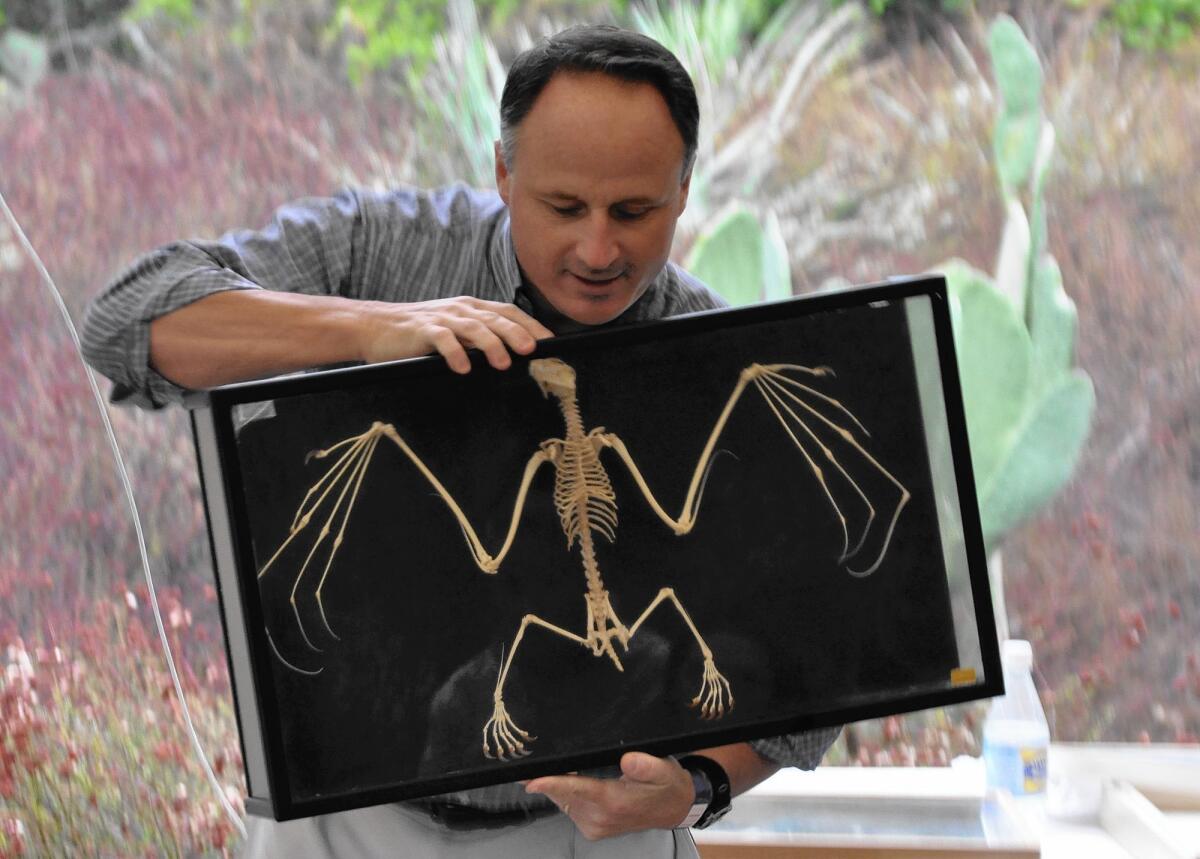You’re batty if you think these creatures want to suck your blood

- Share via
Bats have long been associated with Halloween, a connection fed by the discovery of the vampire bat in the 17th century and the origination of vampire folklore in southeastern Europe during the early 18th century.
Vampire bats are the only mammals that feed entirely on blood, according to National Geographic, but the bats that people might come across in Orange County aren’t manacing. Common bats eat fruit and insects.
So while their teeth are sharp and they look odd, with jagged claws and web-like wings, humans needn’t by startled by them, said Paul Stapp, professor of biological science at Cal State Fullerton.
“People think that they only suck blood or want to bite you,” he said, noting a popular myth.
Every Halloween season, Stapp tries to assure local residents that bats don’t pose a threat to humans.
The Tucker Wildlife Sanctuary was to have held its seventh annual Bat Night on Saturday, when Stapp was scheduled to give his presentation on the nocturnal, winged creatures. The purpose of the event is to bust the common myths about bats.
The sanctuary is a canyon site in Silverado owned by Cal State Fullerton that is used for research projects and public education programs. It has an “All About Bats” exhibit in the small natural science center, but Bat Night is its one activity there that teaches the public how to live cooperatively with bats.
“One easy thing you can do is the leave your porch light on,” sanctuary resource developer Eric Ey said. “By doing this, you’re attracting the insects, which the bats can then feed off of. Even though they’re less noticeable in the urban areas, bats are present throughout the southern California.”
According to Stapp, one big contribution that these flying mammals make to the environment is hunting and consuming insects.
“Some people even think they’re just flying rodents and they’re not valuable to the ecosystem,” said Stapp. “But that’s not true.”
He recalls a study that showed that a colony of about 150 big brown bats can eat around 3 million insect a year.
“If it weren’t for the bats, farmers would have to spend millions per year to control those insects in their crops and fields,” Stapp said.
While Hollywood’s horror flicks depict bats as the creatures that shape shift into blood-sucking vampires, Stapp assures that all bats north of Mexico are nectar- and insect-feeding. Vampire bats of Mexico and South America do, however, feed on the blood of other mammals.
Stapp believes that another bat myth is that they live only in the tropics. But California contains 25 species of bat, and Orange County is home to 16 of them.
One species that can be seen in the sanctuary is the pallid bat, a type that can hear the footsteps of insects and is immune to scorpion venom, Ey said.
One of the most common bats in southern California, and one of Stapp’s favorites, is the Mexican free-tailed bat, a moth-eating mammal that lives under bridges and caves.
After two of his Saturday presentations, Stapp was to take his audience on a “bat walk” so that visitors might get a chance to see the creatures that they, presumably, no longer think of as flying rodents.
While Ey said it takes a bit of patience to find the bats, the best way is to go to a food source when it is dark.
At the canyon site, the creek bed with flying insects was the group’s best bet.
Also on the Bat Night schedule was bat bingo and a crafts session — making bat magnets.
“What everyone always enjoys about the event is that you can come out to the canyon at night and see the whole sanctuary lit up with twinkle lights,” Ey said. “The people really like the nocturnal activities.”